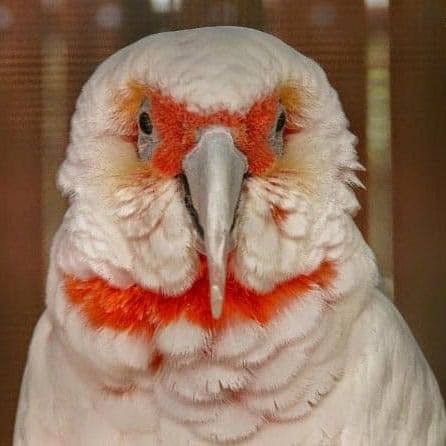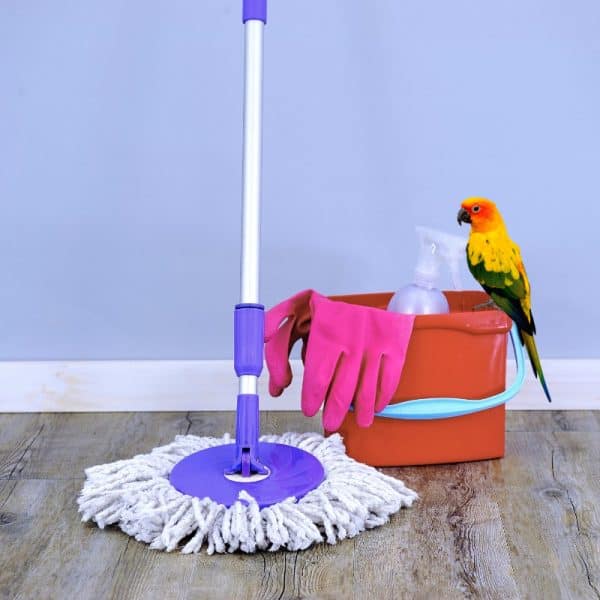Last Updated on by Catherine Tobsing
The beak is an essential part of a parrot’s anatomy, used for eating, climbing, and exploring their environment.
A healthy beak is smooth, symmetrical, and naturally wears down through regular use.
However, various factors can lead to beak overgrowth and abnormalities, potentially affecting your parrot’s ability to eat and engage in normal behaviors.
Understanding the causes, signs, and treatments of these conditions is vital for maintaining your parrot’s overall health.
Causes of Beak Overgrowth and Abnormalities
Several factors can contribute to beak overgrowth and abnormalities in parrots:
- Diet: An imbalanced diet lacking essential nutrients, especially calcium and vitamin D3, can result in poor beak health. Soft foods and a lack of hard items to chew on can prevent the beak from wearing down naturally, leading to overgrowth. Certain species like Eclectus’ beaks can react poorly to a diet that leans heavily on seeds.
- Genetics: Some parrots are genetically predisposed to beak abnormalities, particularly certain species like cockatoos and budgerigars. These genetic conditions may cause uneven beak growth or structural defects that require ongoing care.
- Lack of Natural Wear: In the wild, parrots keep their beaks naturally trimmed by gnawing on branches, seeds, and nuts. Captive parrots often lack these opportunities, especially if they are not provided with sufficient chewable items like natural wood perches and toys. Without the natural wear and tear, the beak can become overgrown.
- Health Issues: Underlying health conditions, such as liver disease, parasites, or infections, can also cause beak deformities. Diseases like Psittacine Beak and Feather Disease (PBFD) can directly impact the beak’s structure and growth.
Signs to Watch For
Monitoring your parrot’s beak regularly is crucial for early detection of abnormalities. Here are some signs that may indicate beak problems:
Overgrown Beak: The upper or lower part of the beak appears longer than normal, potentially curving unnaturally. Overgrowth can hinder your parrot’s ability to eat and groom itself.
Misshapen or Asymmetrical Beak: The beak may look uneven or have visible cracks, ridges, or chips. An asymmetrical beak can indicate improper wear or genetic issues.
Difficulty Eating: If your parrot struggles to pick up food, drops food frequently, or seems to be avoiding certain foods, it might be due to an overgrown or misshapen beak.
Change in Behavior: Changes in normal activities, like a decrease in climbing or chewing, can be a sign that the beak is causing discomfort or pain.
Home Care and Professional Treatment
Proper care at home, along with professional intervention when necessary, is essential for managing beak health.
Home Care
- Provide Chewable Items: Ensure your parrot has access to a variety of chew toys, natural wood perches, and mineral blocks. Chewing on these items helps wear down the beak naturally and keeps it in good shape. Hard, safe materials like untreated pine, java wood, and calcium blocks are excellent for beak maintenance.
- Balanced Diet: A nutrient-rich diet plays a significant role in beak health. Incorporate a variety of fresh fruits, vegetables, seeds, and nuts into your parrot’s diet. Calcium-rich foods and supplements can strengthen the beak, while crunchy foods encourage natural trimming.
- Routine Inspections: Regularly inspect your parrot’s beak for any signs of overgrowth, discoloration, or structural abnormalities. Conduct visual and tactile checks while handling your parrot, paying attention to any changes in shape or texture.
Professional Treatment
If you notice signs of overgrowth or abnormalities, it’s crucial to seek the assistance of an avian veterinarian for proper diagnosis and treatment. Here’s what a vet may do:
- Beak Trimming: If the beak is overgrown, the vet can trim it safely using specialized tools. Attempting to trim the beak at home is not recommended, as improper trimming can cause injury, bleeding, and further complications. Do not try this yourself. A parrot’s beak is filled with nerves and the wrong move could prove painful.
- Diagnostic Tests:** The vet may perform tests to identify underlying health issues contributing to the abnormal beak growth, such as blood tests to check for nutritional deficiencies or liver disease.
- Treatment of Underlying Conditions: If the beak abnormality results from an underlying health issue (e.g., PBFD, liver disease), the vet will develop a treatment plan that may include medication, dietary changes, or other interventions.
- Regular Check-ups: Some parrots, especially those with genetic predispositions to beak problems, may require regular vet visits for routine beak maintenance and monitoring.
By providing appropriate chew toys, a balanced diet, and regular inspections, you can help keep your parrot’s beak healthy. However, if you notice any issues, professional intervention is key to prevent more serious health problems and ensure your parrot’s well-being.
Written by Mitch Rezman and the Windy City Parrot Content Team
Author Profile
Latest entries
 The Traveling BirdJune 26, 2025Can You Name 5 Parrot Species That Are Living Wild in the USA?
The Traveling BirdJune 26, 2025Can You Name 5 Parrot Species That Are Living Wild in the USA? Bird BehaviorJune 26, 2025How is it Parrots Are Problem Solvers Social Animals and Even Use Tools?
Bird BehaviorJune 26, 2025How is it Parrots Are Problem Solvers Social Animals and Even Use Tools? Bird & Parrot AnatomyJune 25, 2025How a Tiny Chemical Modification Makes Parrots Nature’s Living Paintings
Bird & Parrot AnatomyJune 25, 2025How a Tiny Chemical Modification Makes Parrots Nature’s Living Paintings PigeonsJune 20, 2025How Do Parrots Thrive in Cities Outside Their Native Habitats?
PigeonsJune 20, 2025How Do Parrots Thrive in Cities Outside Their Native Habitats?




